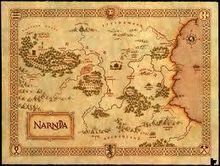Other name(s) Narnia Genre Juvenile fantasy Creator C. S. Lewis | Created by C. S. Lewis Type Absolute Monarchy | |
 | ||
Ethnic group(s) Telmarines, Dwarfs, Giants, Fauns, Centaurs, Nymphs, Marsh-wiggles, etc. Notable locations Cair Paravel (capital), Lantern Waste, Beaversdam, Beruna Notable people Mr. Tumnus, Jadis the White Witch, Prince Caspian, Trumpkin | ||
In C. S. Lewis's Chronicles of Narnia series of novels, Narnia is the country around which the books revolve. It is one of several lands in the Narnian world.
Contents
Geography
Narnia is a land of rolling hills rising to low mountains in the south. It is predominantly forested except for marshlands in the north. The country is bordered on the east by the Eastern Ocean, on the west by a great mountain range, on the north by the River Shribble, and on the south by Archenland.
The economic heart of the country centres on the Great River of Narnia, which crosses the country from the northwest on an east-southeasterly course to the Eastern Ocean. The seat of government is Cair Paravel, at the mouth of the Great River. Other communities along the river include (from east to west) Beruna, Beaversdam, and Chippingford.
Regnal history
While only some kings and queens are named in the book, the custom of Narnians to name sons after fathers, as well as a timeline that Lewis wrote outside of the series proper, helps create a fairly complete list of monarchs in the world of Narnia. This table gives the regnal years of the monarchs, as determined by the timeline and clues in the books themselves.
Titles
When monarchs are installed on the throne of Narnia, they receive the following titles:
They may also receive the following titles:
Narnia and Narni (Italy)
C. S. Lewis took the name from the Italian town of Narni, whose Latin name was in fact Narnia. Concerning Narnia and Narni Roger Lancelyn Green writes about C.S. Lewis and Walter Hooper:
When Walter Hooper asked [C.S. Lewis] where he found the word 'Narnia', Lewis showed him Murray's Small Classical Atlas, ed.G.B. Grundy (1904), which he acquired when he was reading the classics with Mr Kirkpatrick at Great Bookham [1914-1917]. On plate 8 of the Atlas is a map of ancient Italy. Lewis had underscored the name of a little town called Narnia, simply because he liked the sound of it. Narnia — or 'Narni' in Italian — is in Umbria, halfway between Rome and Assisi.
Narnia, a small medieval town, is situated at the top of an olive-covered hill. It was already ancient when the Romans defeated it in 299 BC. Its thirteenth-century fortress dominates a deep, narrow gorge of the Nera river which runs below. One of its most important archaeological features is a Romanesque cathedral, which contains the relics of a number of Umbrian saints.
